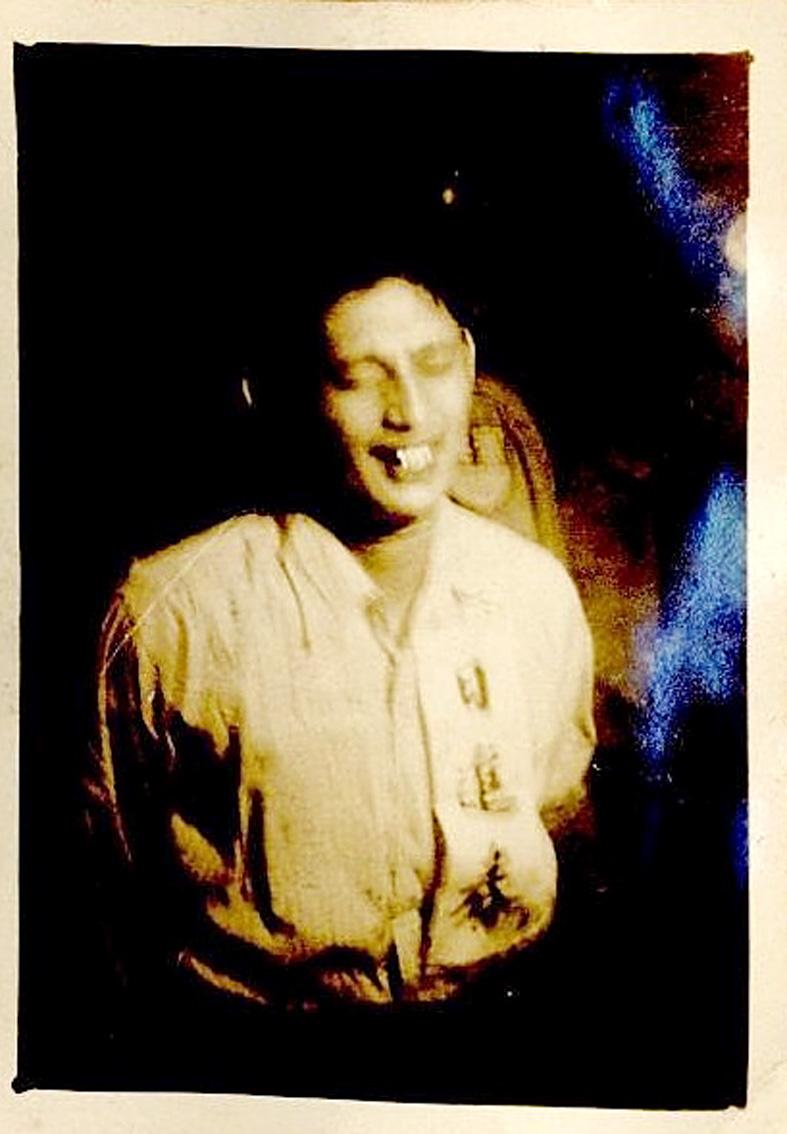Jih Chin-chun (日進春), a member of the Saisiyat community, was the first Taiwanese Aborigine to fall victim to the White Terror era when he was shot by Chinese Nationalist Party (KMT) military police at a riverbank in Taipei 69 years ago, the Transitional Justice Commission said yesterday.
Jih has been memorialized by a picture, in which he is shown laughing, captured just before he was executed on Aug. 29, 1952, the commission said.
The commission said that it has asked researchers to compile a booklet on transitional justice measures focusing on Taiwan’s Aborigines, including Jih, as well as stories of Paiwan youth Lai Hung-man (賴紅炎) and other Aboriginal victims of the period.

Photo courtesy of the Transitional Justice Commission
The commission said it hopes later generations of Aborigines can learn about the injustices their communities faced during the period.
Jih was shot five times, and his body was left on a pile of corpses in the Liuzhangli (六張犁) area of Taipei, forgotten until the present day, the commission said.
Jih’s father, Jih A-kuai (日阿拐), was the head of a Saisiyat community and went into hiding to avoid capture during a rebellion against the Japanese in 1902, in what is now Miaoli County’s Nanjhuang Township (南庄), it said.
Jih A-kuai died a year later in what now is Luchang Borough (鹿場) of Hsinchu County’s Jhubei City, it said.
Jih Chin-chun was detained after being involved in the case of Chang Yan-mei (張燕梅), it said. Chang was a teacher at Taipei’s Penglai Elementary School and a member of the Taipei Workers’ Committee, a group of Chinese Communist Party sympathizers planted within various government agencies.
Jih Chin-chun once gave Chang an autobiography, but he never participated in any committee meetings, the commission said.
Although he was able to avoid Jih Chin-chun’s fate, Lai had been wrongly accused of dissidence due to his random jottings while he was a student, in which he would raise questions about how to improve the futures of fellow Aborigines, it said.
He was eventually taken for questioning while he was teaching at Taitung’s Jialan Elementary School in 1965 and detained for several days, it said.
The White Terror era refers to the suppression of political dissidents including the 228 Incident, an uprising that began on Feb. 27, 1947, which was brutally suppressed by the then-KMT regime. The government subsequently imposed martial law, which was lifted on July 15, 1987.

Taiwan is to commence mass production of the Tien Kung (天弓, “Sky Bow”) III, IV and V missiles by the second quarter of this year if the legislature approves the government’s NT$1.25 trillion (US$39.78 billion) special defense budget, an official said yesterday. Commenting on condition of anonymity, a defense official with knowledge of the matter said that the advanced systems are expected to provide crucial capabilities against ballistic and cruise missiles for the proposed “T-Dome,” an advanced, multi-layered air defense network. The Tien Kung III is an air defense missile with a maximum interception altitude of 35km. The Tien Kung IV and V

The disruption of 941 flights in and out of Taiwan due to China’s large-scale military exercises was no accident, but rather the result of a “quasi-blockade” used to simulate creating the air and sea routes needed for an amphibious landing, a military expert said. The disruptions occurred on Tuesday and lasted about 10 hours as China conducted live-fire drills in the Taiwan Strait. The Civil Aviation Administration (CAA) said the exercises affected 857 international flights and 84 domestic flights, affecting more than 100,000 travelers. Su Tzu-yun (蘇紫雲), a research fellow at the government-sponsored Institute for National Defense and Security Research, said the air

Taiwan lacks effective and cost-efficient armaments to intercept rockets, making the planned “T-Dome” interception system necessary, two experts said on Tuesday. The concerns were raised after China’s military fired two waves of rockets during live-fire drills around Taiwan on Tuesday, part of two-day exercises code-named “Justice Mission 2025.” The first wave involved 17 rockets launched at 9am from Pingtan in China’s Fujian Province, according to Lieutenant General Hsieh Jih-sheng (謝日升) of the Office of the Deputy Chief of the General Staff for Intelligence at the Ministry of National Defense. Those rockets landed 70 nautical miles (129.6km) northeast of Keelung without flying over Taiwan,

City buses in Taipei and New Taipei City, as well as the Taipei MRT, would on Saturday begin accepting QR code payments from five electronic payment providers, the Taipei Department of Transportation said yesterday. The new option would allow passengers to use the “transportation QR code” feature from EasyWallet, iPass Money, iCash Pay, Jkopay or PXPay Plus. Passengers should open their preferred electronic payment app, select the “transportation code” — not the regular payment code — unlock it, and scan the code at ticket readers or gates, General Planning Division Director-General Liu Kuo-chu (劉國著) said. People should move through the